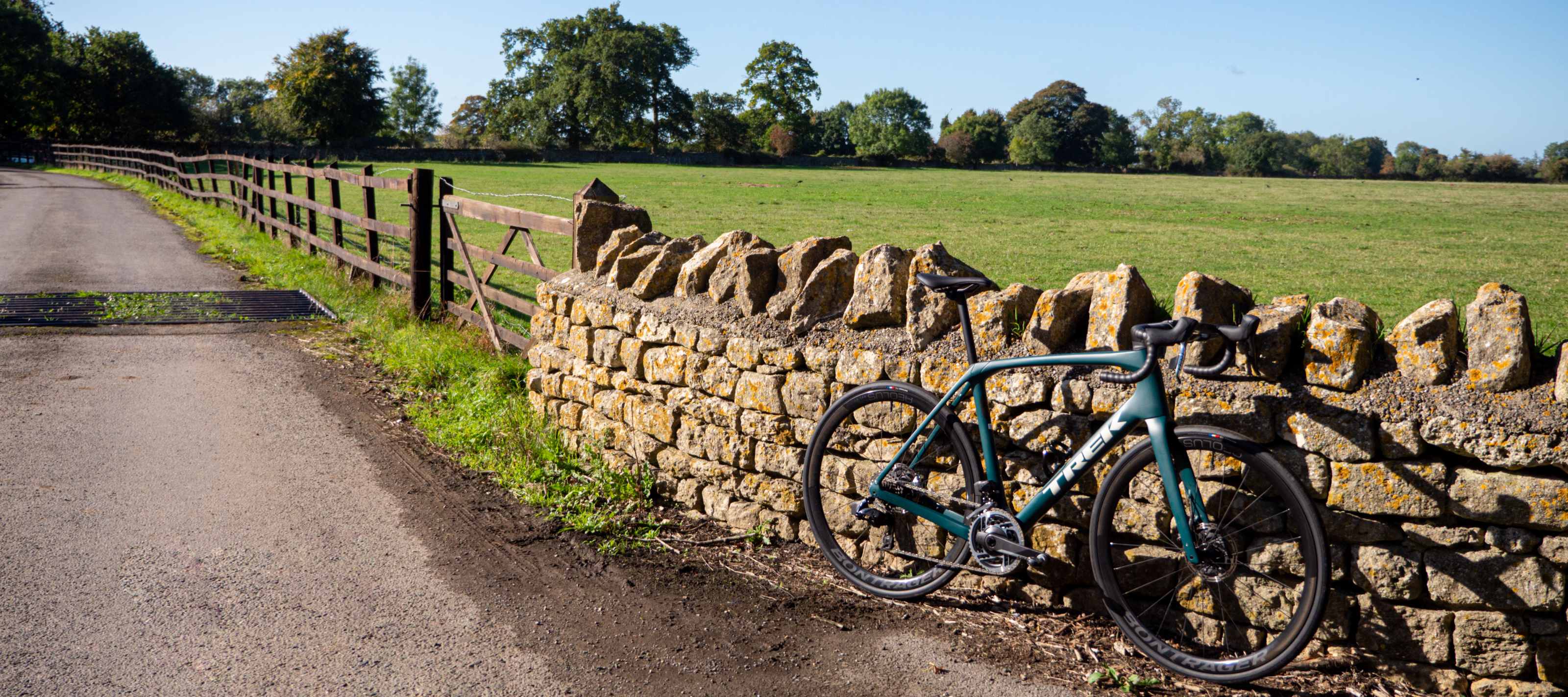Cyclingnews Verdict
A genuinely excellent dual-natured bike, but at a price that could realistically buy three still-excellent bikes
Pros
- +
Easy to use storage compartment with neat & organising tool wrap
- +
Simplified Isospeed vibration damping
- +
38mm tyre clearance
- +
Power meter included
- +
Neat, low-maintenance integrated cockpit
Cons
- -
Oh boy is it pricey
- -
I would hope for top-spec tyres at this price
You can trust Cyclingnews
The Trek Domane is not what it once was.
Cast your mind back to around 2015, when gran fondos - or sportives - were all the rage among keen amateur cyclists. Road bike ranges were easy to comprehend thanks to the distinct three-way category split: lightweight, aero, and endurance.
The Trek Domane had been in existence for two years at this point, and like the Specialized Roubaix, Cannondale Synapse or Giant Defy, was fast becoming synonymous with the 'endurance road' category. Gravel was still an up-and-coming neo pro, while Allroad was trademarked by Audi.
The original Domane was fitted with something Trek calls an Isospeed decoupler at the seatpost. Put simply, this allowed the seatpost to flex independently from the frame, retaining pedalling efficiency while adding comfort. For Domane version-two, which launched in 2016, Trek took this concept and ran with it. That Isospeed was given a sliding adjustment to allow riders to tailor their ride quality to their preference, and a second Isospeed was built into the handlebar, decoupling the handlebars from the buzz of the road, adding comfort at the front too.
Domane version three launched in 2020 and at first glance remained largely the same formula as the last. It retained the adjustable Isospeed and continued to be all about comfort, just with a sharper focus on aerodynamics, but when you look a little closer, I believe it marked a step change in the Domane's character. With tyre clearance ballooning to 38mm, the Domane was among the most progressive endurance road bikes available.
Some would liken it to what we now know call an 'all-road' bike; the halfway-house between road and gravel, able to handle well-graded gravel paths, but without giving up too much speed on the road.
For 2023 and version four, Trek has really signalled this change of direction. It has gone back to basics on the Isospeed front, with a reduction in weight and a refinement of the aerodynamics. However, the 38mm clearance remains, the geometry continues to focus on comfort, and the result is a bike that's really tough to categorise on paper.
The latest race content, interviews, features, reviews and expert buying guides, direct to your inbox!
Is this still an endurance road bike? Or is it an all-road bike? Is it a do-it-all superbike? In order to find out, I spent a few months with the bike, taking it on all sorts of ride, short and long, smooth and gravel, wet and dry, and even on the indoor trainer.
Geometry
While often mentioned, geometry doesn't usually get a section to itself in bike reviews here at Cyclingnews, but it's worth talking about because it's here that I believe we can start to work out exactly where the 2023 Trek Domane fits in among the hundreds of other bikes on the market.
First up it makes sense to compare it to its long-time competitors, the 'endurance road' crowd, including the Roubaix, Synapse and Defy.
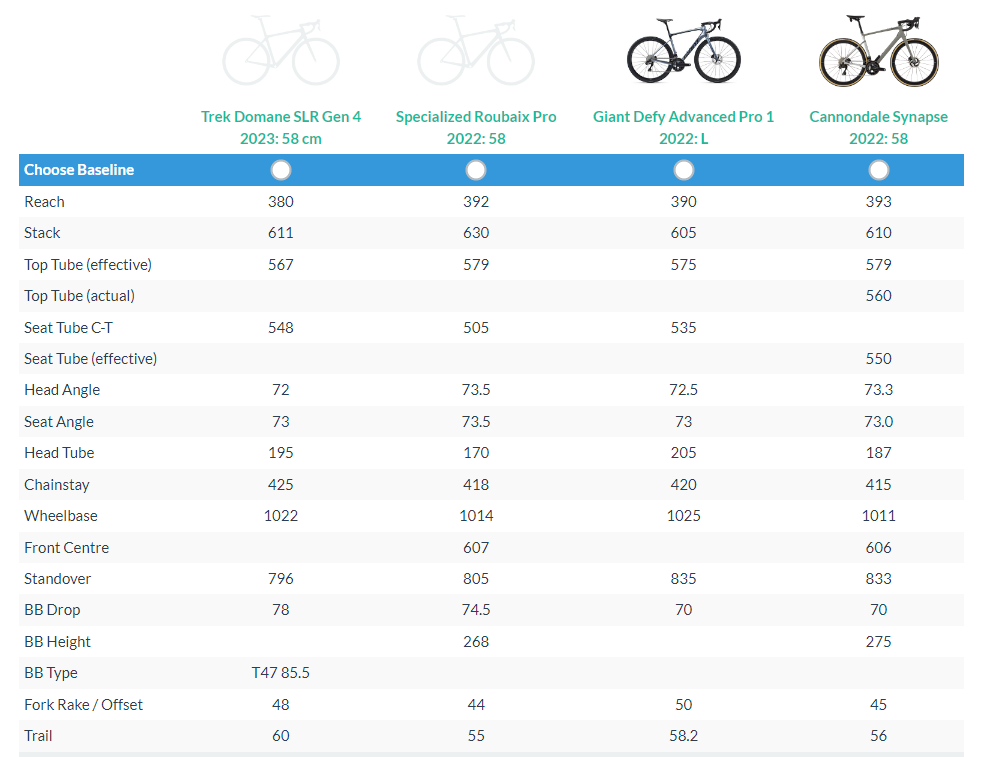
You can see that of all four bikes, the Domane's reach is the shortest by 10mm, and stack is fairly average. The numbers are pretty close though, so there's nothing to really write home about here. However, with a slacker head angle, a long wheelbase and a high BB drop, it points to offering a slightly more surefooted ride when the going gets rough.
Does that mean it's now more in line with bikes being marketed as 'all-road' bikes? The 38mm tyre clearance mimics the Fara All Road and the Ridley Grifn, for example, so let's compare to those and find out:
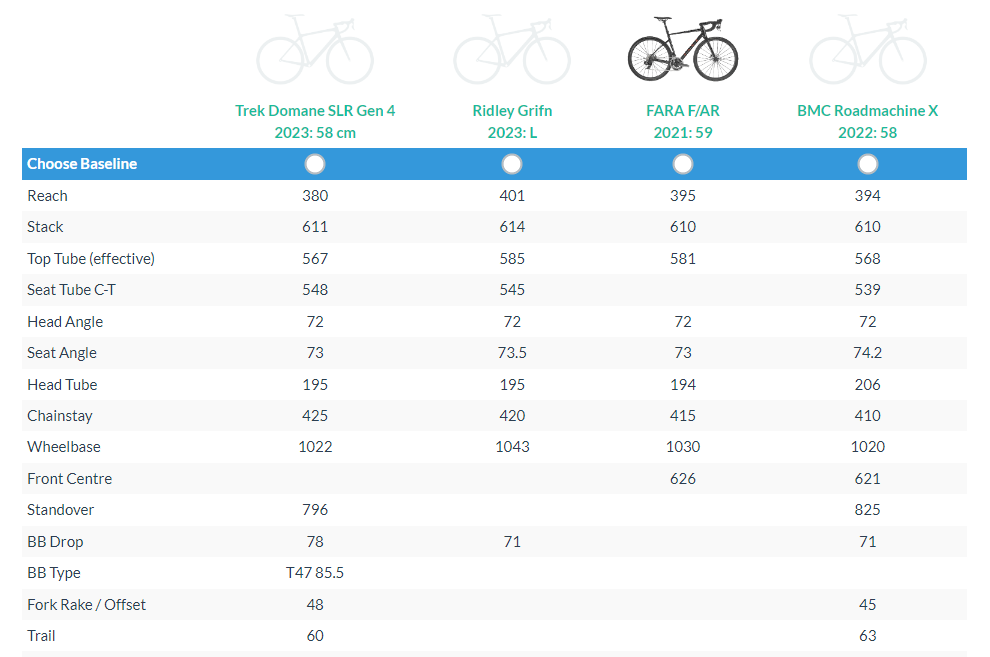
Here you'll see the head angle is exactly the same as the other three bikes, at 72 degrees, suggesting it does indeed fit better into this 'all-road' category. However, the wheelbase is only 2mm off being the shortest shown.
As a result, if I'm forced to categorise it, I think it's safest to do so as 'somewhere in between' the typical endurance road sector and what brands are now calling all-road. However, more important than a label is an analysis of how those geometry numbers combine with the design, the build quality, the components, and how the resulting bike actually rides.
Design & specifications
The 2023 Domane is available in three different guises: Domane SL and Domane SLR, with the carbon fibre level and component specs improving with the additional R. There's also the RSL, which stands for Race Shop Limited, and sits at the same level as the SLR, but in a more race-ready guise with a longer and lower geometry and no downtube storage.

The model I'm testing is the Domane SLR 9, with a full serving of top-tier components and a top-tier price to boot: £13,400.00 / $13,199.99 / €14,499.00.
There's no getting around it, that's an enormous amount of money. It's almost unforgivable. It's impossible to ignore. And it's part of the reason I've written 800 words before even telling you which version of the Domane I'm reviewing. It's £4,900 more than the equivalent-spec Giant Defy. It's £4,400 more than a Cannondale Synapse Dura-Ace, and while the S-Works Roubaix is closer, it's still £400 more expensive than that.
However, it's worth noting that there are cheaper versions available, and many of the SLR 9's standout features translate right down to the cheapest Domane SL 5 at £3,400.00 / $3,499.99 / €3,749.00. As I proceed through the rest of this review, I will do my best to serve those who are considering this very bike, while also highlighting the features that trickle down to the more affordable models.
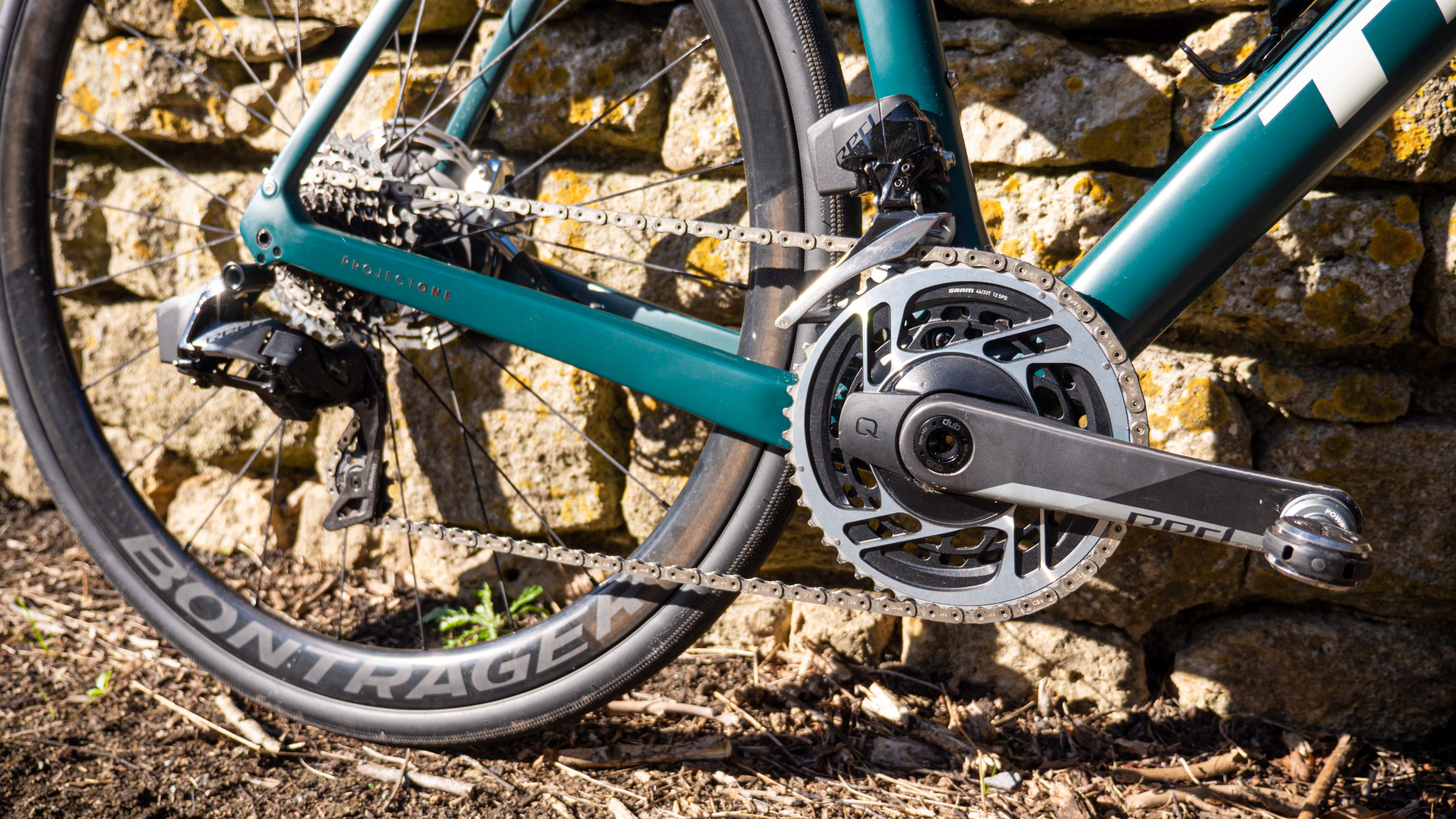
The Domane SLR 9 on test is fitted with Sram's top-tier Red eTap groupset, complete with the integrated power meter (the infuriating one with the power meter integrated into the chainrings), Bontrager Aeolus RSL 37 wheels, Bontrager Verse Short Pro carbon-railed saddle and Bontrager Pro IsoCore bars. The only area where the spec falls short of expectation at this price point is the Bontrager R3 tyres. They're good all-rounders, but the more supple R4 would probably have been more in line.
My size 58cm weighs in at 7.9kg. Given that includes pedals, a bottle cage and the tool roll inside the down tube storage, this is impressive given Trek quotes 7.8kg for a 56cm without all of the above. This model is available in five stock colours, but dozens of colourways are available throughout the range, and Trek also has Project One, which allows you to choose from thousands of combinations. This particular test bike is finished in a matte green colour that Trek calls juniper, my experience with Trek's paint is usually positive, but on this model, the paint chipped quite easily when my front light knocked against it on one ride.
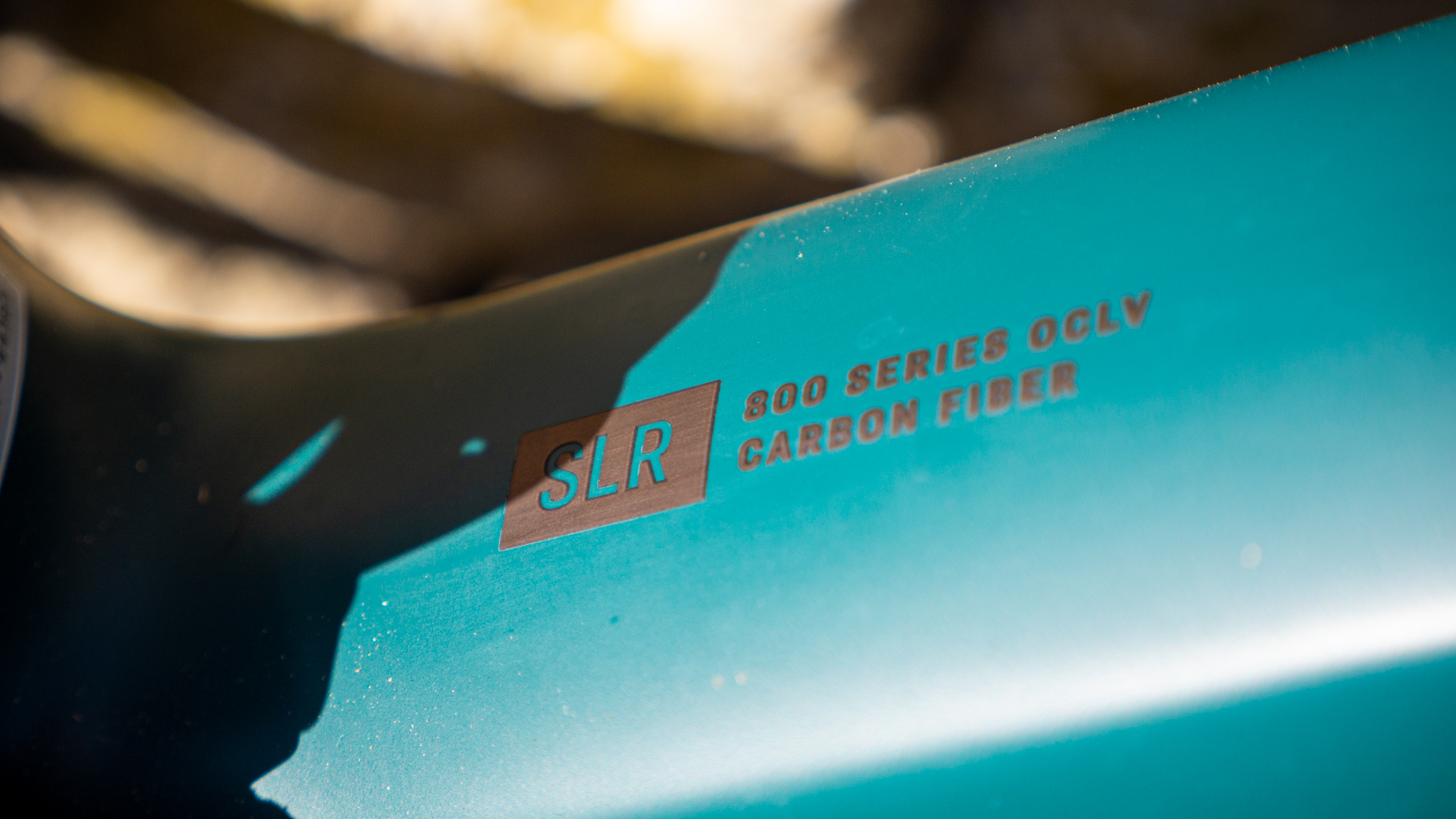
The 2023 Trek Domane SLR is upgraded to Trek's top-tier OCLV 800 carbon (SL uses the cheaper, less-refined OCLV 500). The frame has retained a similar silhouette to before, but Trek has simplified things massively with regard to the Isospeed decouplers. The front Isospeed has been removed entirely, while the rear is no longer adjustable, as it was before. For gen 4, all models (Domane SLR, RSL, and the cheaper SL) get the same Isospeed setup.
The frame's tubes see a slight refinement of their aerodynamic profiling, with the head tube being deep in shape with a truncated rear edge, and a slight D-shape to the seatpost too. Trek is certainly not the first to use a D-shaped post, and while Trek itself doesn't tie any comfort claims directly to it, the shape has been widely adopted by other brands, with most claiming comfort gains and mildly improved aerodynamics.
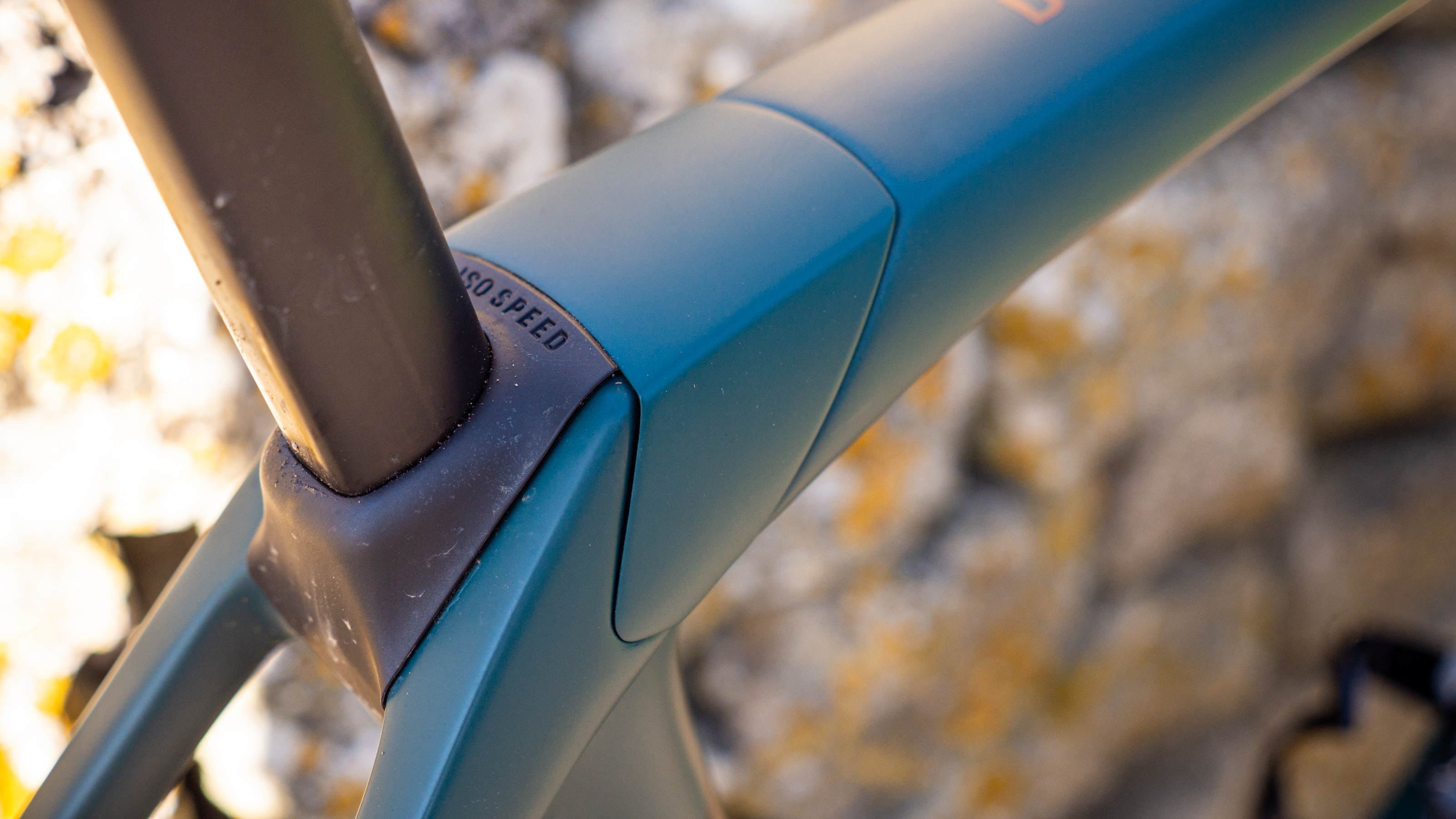
Another departure from the prior Domane SLR is the removal of the protruding seat tube, so now the post enters the frame where you'd usually expect it to, at the top tube junction, in front of which is a magnetic cap that hides the Isospeed and the seatpost clamp.
The cockpit too is considerate of airflow, but in a way that won't waste a day whenever you need to adjust your spacers or swap your stem or handlebars. The brake hoses run beneath the bar tape – rather than inside the bars – and under the stem into a scoop-shaped adaptor that fits in front of the proprietary Bontrager RCS Pro stem. Beneath this, oval spacers (splittable, thank heavens) allow cables to run into the frame. This is true for all models in the range.
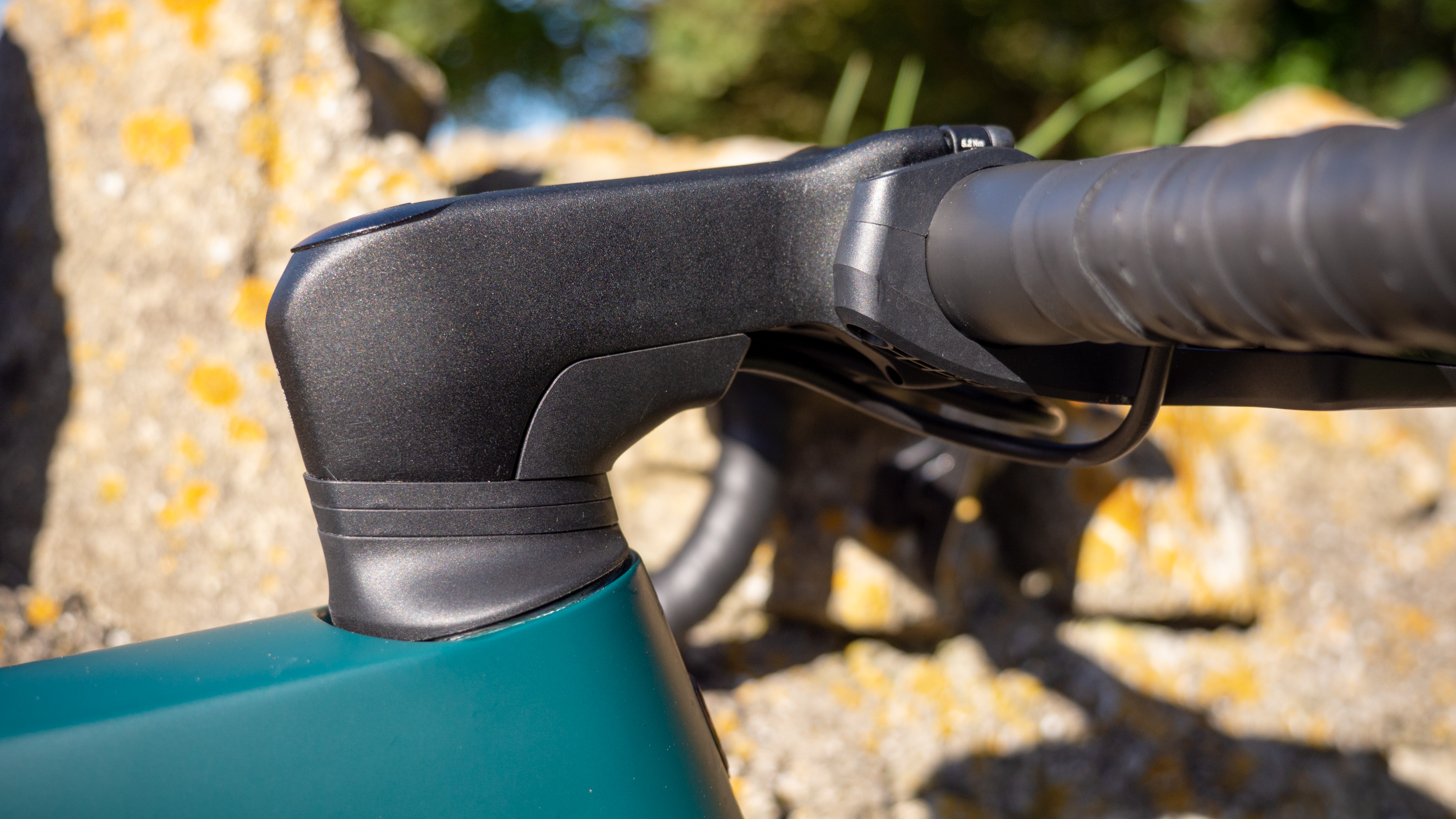
Like many bikes with internal cable routing, the brake hoses and/or cables do thread through the bearing cover and the bearings, so any eventual headset replacement will require a little extra work than the previous Domane, which ran cables into a separate port on the top tube behind the stem.
The down tube of the frame retains the door for in-frame storage. Inside, Trek supplies a tool roll, which is big enough to house a couple of tubes, levers, Co2 canisters or any of the best mini pumps. The door doesn't hinge as you'd expect. Instead, it has a latch to lock it into place, and comes away entirely when opened. Both the Domane SLR and SL models get this feature, but the racy RSL eschews it to save weight.
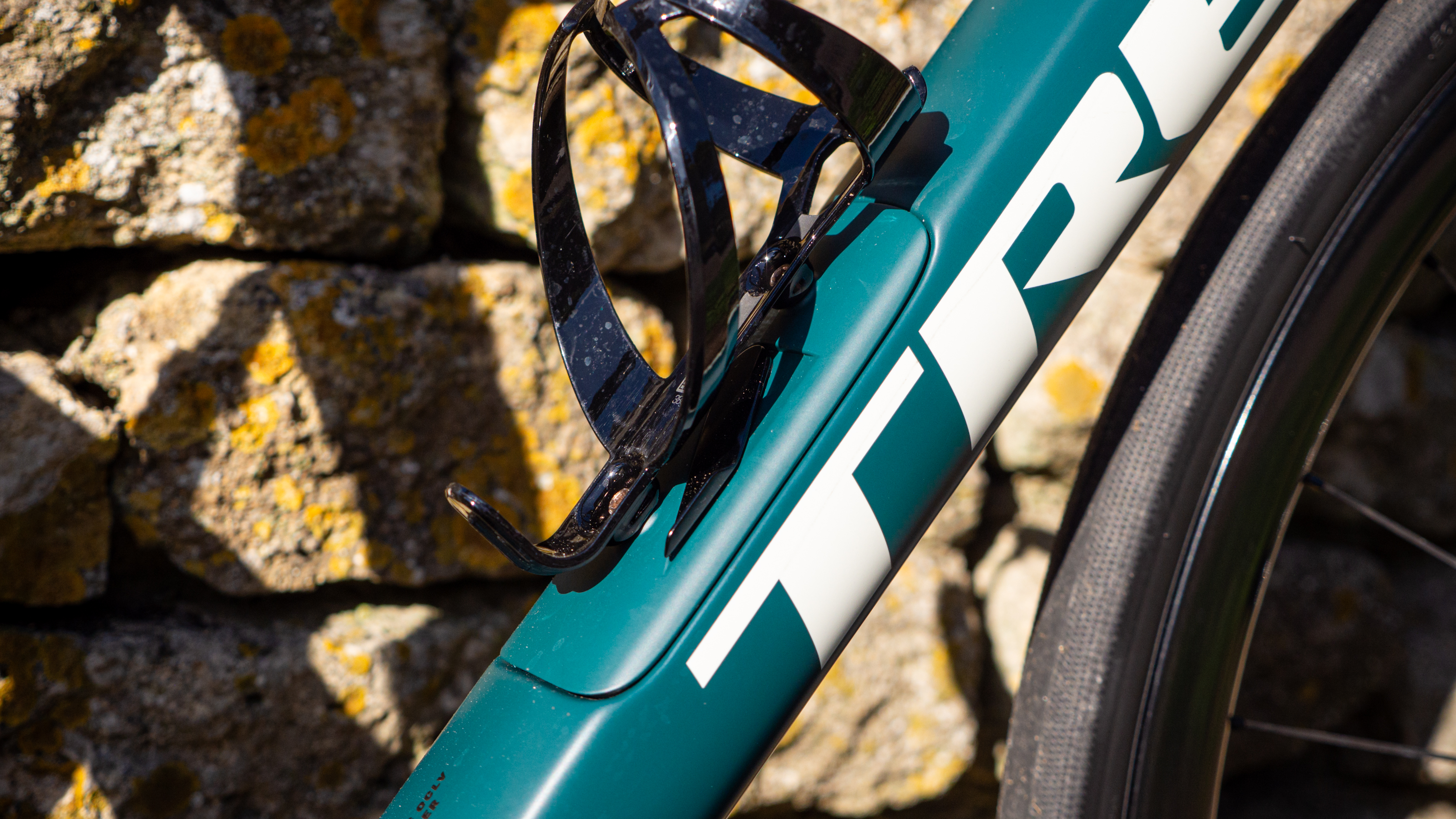
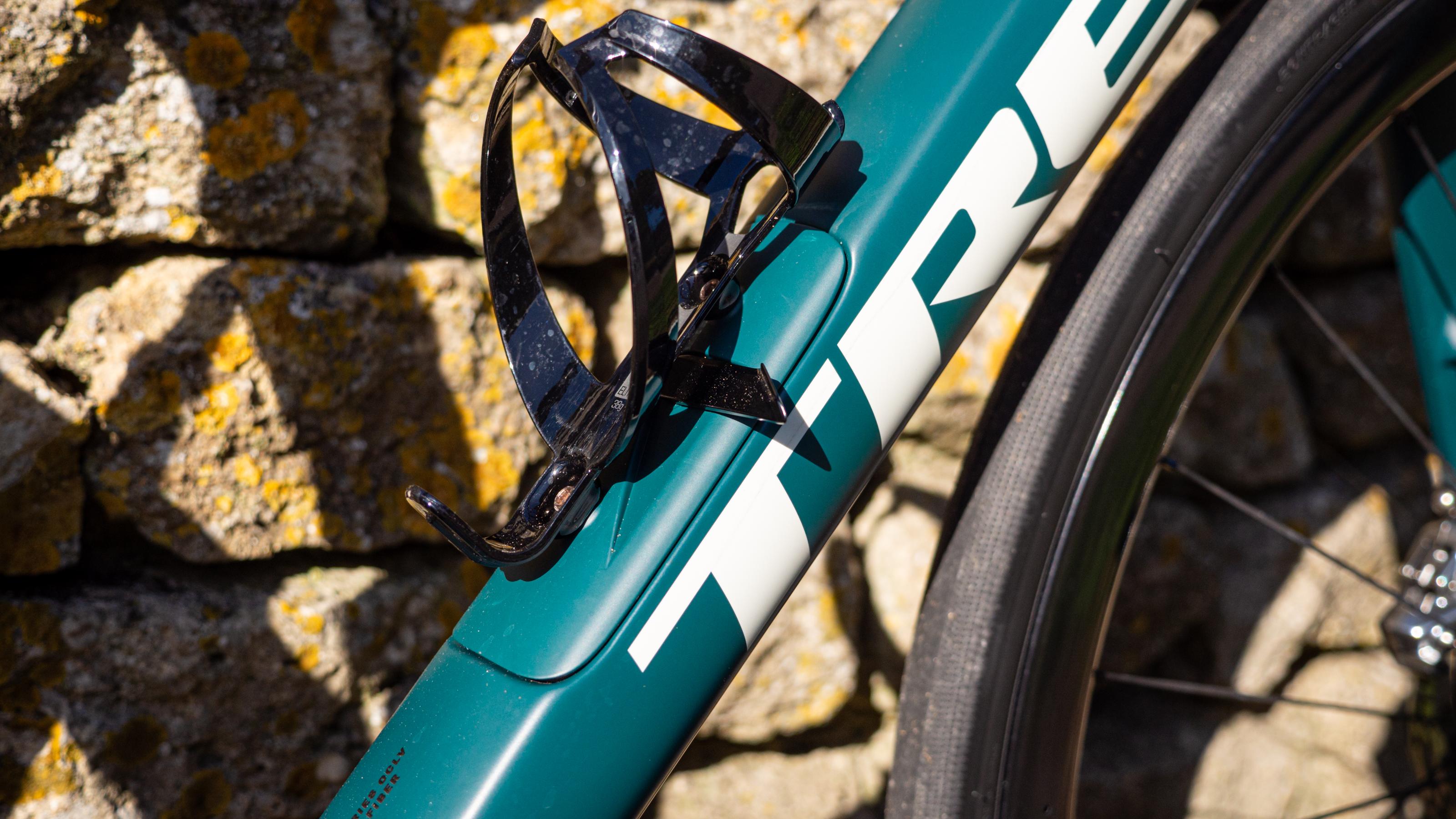
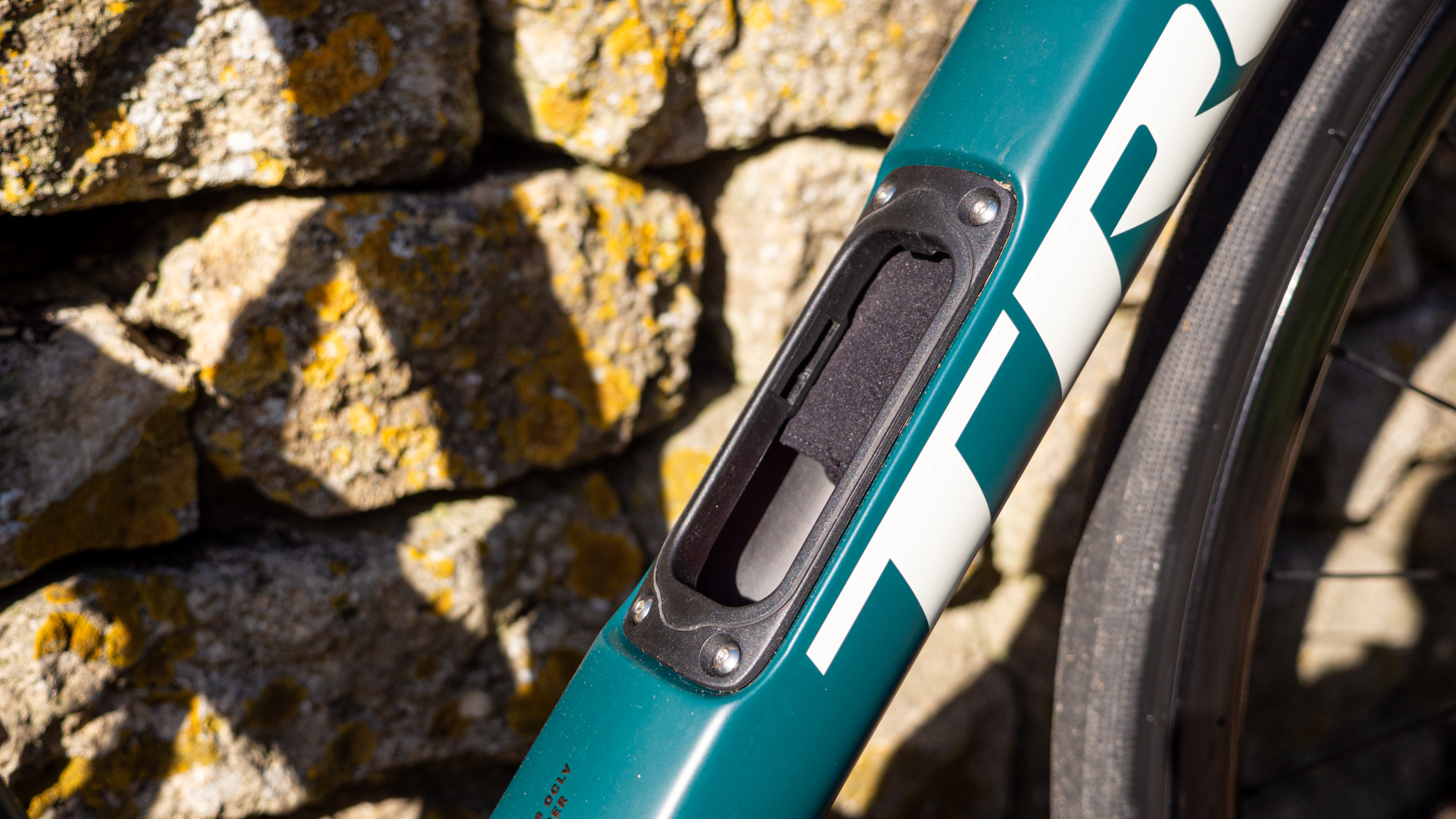
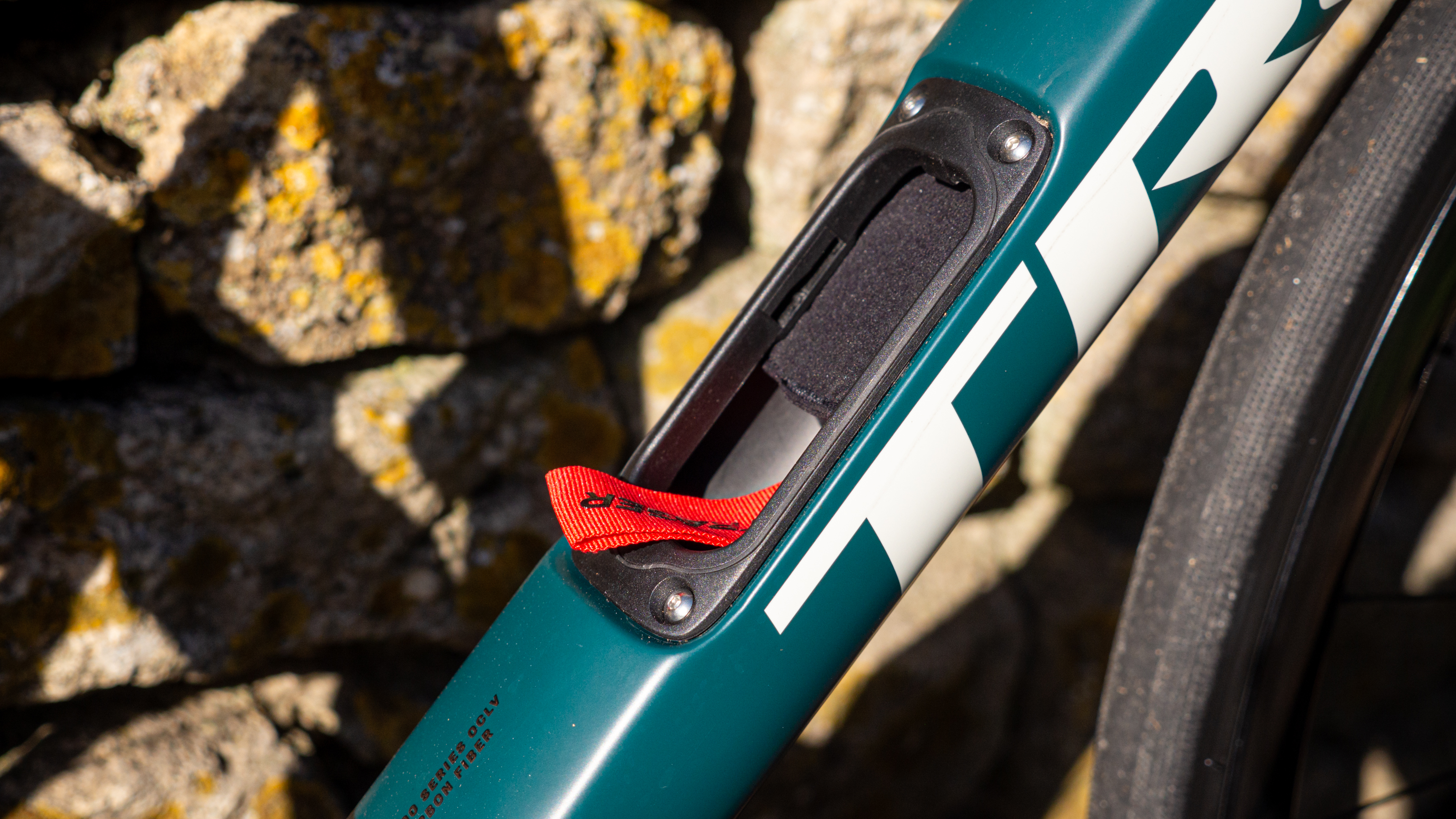
One bottle cage fits onto the outside of the door, another can be fitted to the seat tube, and a third can be fitted to the underside of the down tube. There are also bolts on the top tube behind the stem for a top tube bag. The SL and SLR frames are complete with mounts for full-length mudguards too.
Performance
It's a bit of a cliche to say that you can judge the quality of a bike right from the first pedal stroke, but the Domane SLR is as close as I've come to that very feeling. The high spec, top-level carbon and lightweight platform combined to give the bike a sense of urgency and immediacy. Of course, there was a lot more analysis still to be done, but as far as first impressions go, this was excellent.
Throughout the next few rides, though, I couldn't help but feel underwhelmed by the comfort it offered. A slight caveat here is that I didn't get on with the saddle, and things did improve a little after swapping, but the uber-damped ride quality is no longer what you get from the Domane. That's not to say I didn't enjoy the ride, it's just not the Rolls Royce ride I expected, and almost certainly is a result of the simplified Isospeed setup.
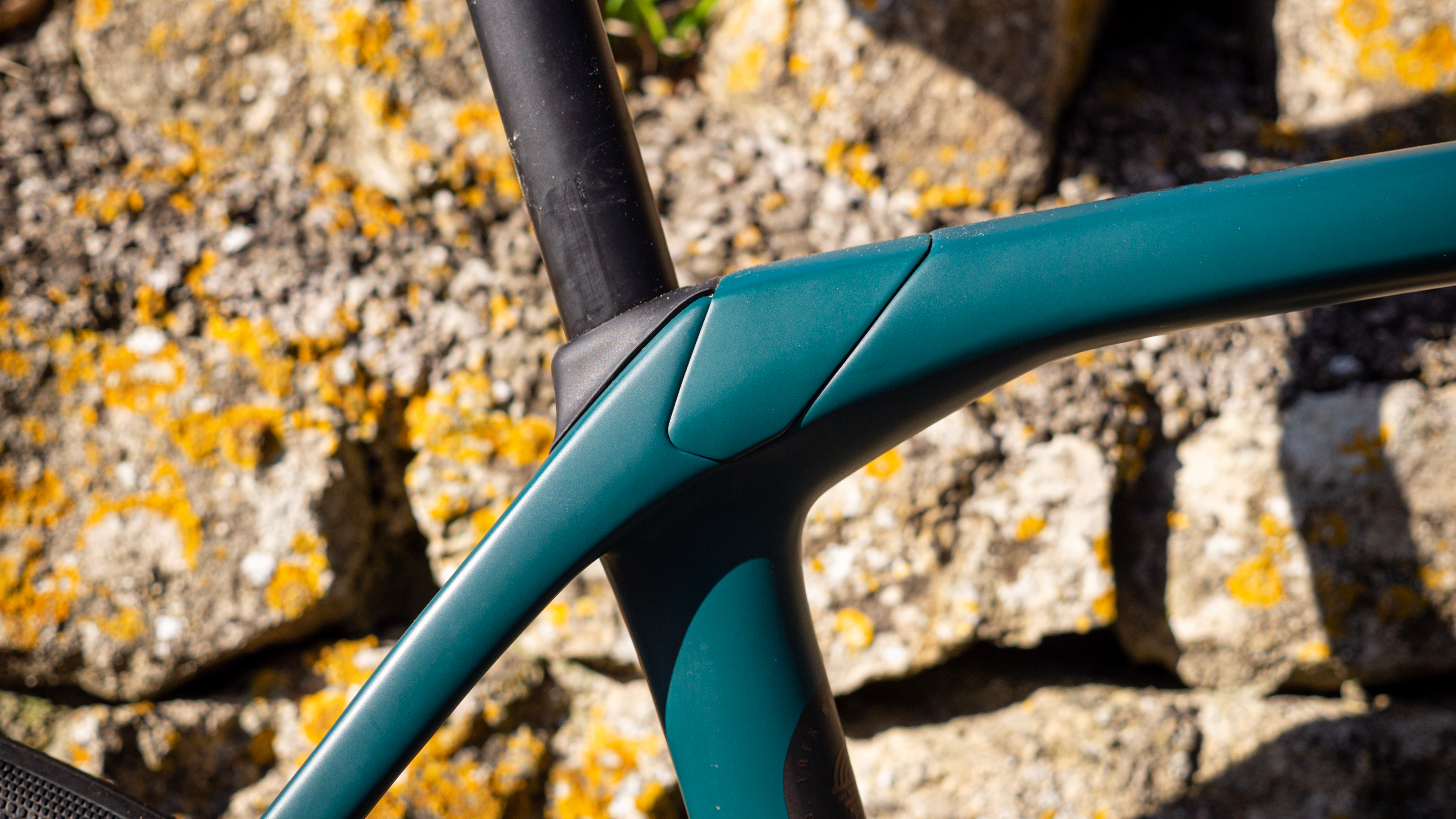
I even took to mounting the bike to my turbo trainer and setting a mirror to my side to see how much deflection was taking place compared to other bikes I have at my disposal. However, after some reflection (pun not intended), I concluded that while it's not what I was expecting, I actually much prefer it this way. The Isospeed decouplers on the previous bikes were good, but they could dull the ride, were heavier, and were complicated. Now, it feels as though the simplified Isospeed balances the stiff pedalling platform to provide a comfy bike that is snappy to accelerate. The new Domane is lighter, faster, more in tune with the road, and seriously fun to ride, but it's still comfortable, and can head off-road if you want it to.
If you want a Rolls Royce ride, then it's probably not the right bike, but for what the Domane is, I don't think many people will want comfort beyond what you can get from simply upgrading the tyres and upsizing to 38mm. If you want something capable of absorbing more vibration than this, I would speculate your choice of terrain is more 'gravel' than 'road', and the 45mm clearance of the Trek Checkpoint might make that a better choice.
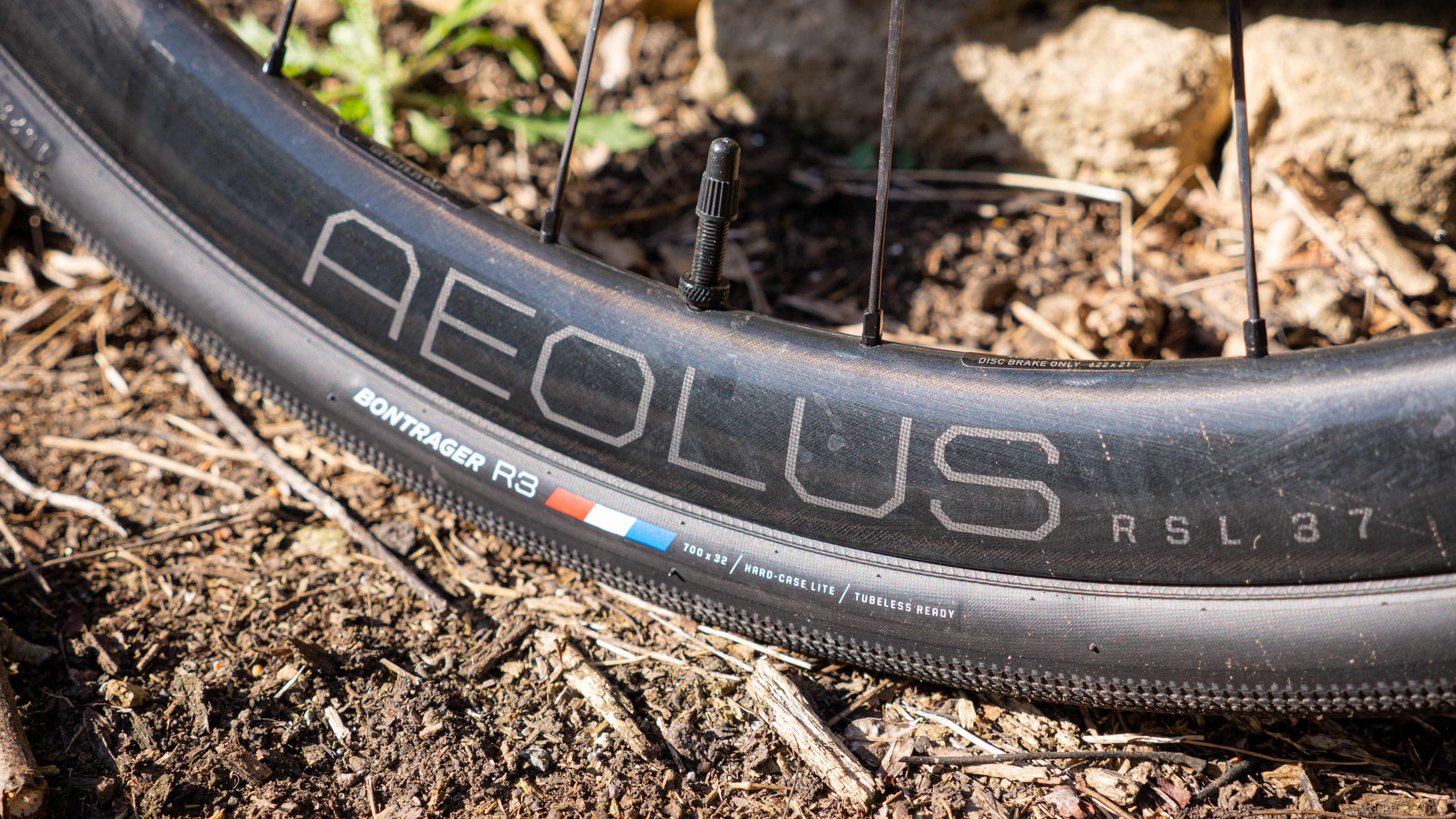
That doesn't mean you can't take this bike onto gravel paths, though. Trek specifically says "the Domane is the perfect choice for long road rides, light gravel back roads and even racing the infamous cobbles of Paris-Roubaix," and it's on those 'light gravel trails' that I'd draw the line too. It certainly doesn't fall apart on technical gravel and singletrack, but as with all all-road bikes, it's more a case of 'you can' rather than 'you should'.
On less technical terrain, its slack head angle and long (1022mm) wheelbase really kept it stable on my local gravel paths, stable enough that I could comfortably go for long stretches sat up riding no-handed without concern, yet it was still nimble enough to dodge puddles (there have been a lot of these lately). Given how the handling compared to the Fara All Road and Ridley Grifn, this is as much an all-road-capable bike as those that are specifically marketed as such.
Despite that, I still think the Domane shines brightest on properly paved roads. In fact, it's still most at home on those high-paced endurance fondos that the Domane called home all those years ago. Nowadays it does that better, while also being able to do more. I wish I had it available during my 275km ride at the Chasing Cancellara sportive last year, it would have been excellent.
Value
I've touched on it above already, but the price of the Domane SLR 9 is prohibitively high. It's a genuinely excellent bike, but it's not £4,900 better than the equivalent-spec Giant Defy that I spent a few weeks riding beforehand. Nor is it £8,800 better than the Force-equipped Fara All Road.
Of course, if you have this sort of cash and you want to spend it here, then the bike you receive will be great; just read below, and you'll see I've given it a 10/10 on performance. However, this money brings you squarely into the realm of fully custom-made bikes, in steel, titanium and even carbon. The Argonaut GR3, for example, is a carbon fibre gravel bike custom laid to your preferences. Even if there is no obvious performance benefit, having something made specifically for you is innately more special.
In my eyes, the purpose of an 'all-road' bike is as a compromise; you want a bike that can head off-road, but you don't want to lose out on your road performance, you perhaps can't afford to buy both a road bike and a gravel bike. As a result, something that straddles the lines without being sluggish on the road is a good choice. The Domane sits in that bracket, and it's a good bike.
However, this price doesn't scream compromise, so unless your reason for buying is because you specifically want to stitch together road and off-road terrain into one ride, rather than having a bike that can do both separately, I'd suggest buying two - perhaps even three - bikes that broaden the spectrum of the terrain you can cover and how well you can cover it. For example, you could buy that Giant Defy and have enough spare change to buy a Rival-equipped Trek Checkpoint for your adventure days.
If covering all terrain in one ride is your goal, you want the absolute best spec that money can buy, you want to buy off the shelf rather than custom, and you can afford to drop £13,400 / $13,199 / €14,499 on getting it, then you won't be unhappy with the Domane SLR 9. However, I would still suggest buying the Dura-Ace Di2 version, which is a little cheaper, and you won't have to buy an entirely new power meter when your chainrings wear out.
Verdict
All in all, the mixed geometry and wider-than-road tyre clearance mean the 2023 Trek Domane stands almost alone in its category. Based on how it rides, I'd be surprised if more don't try to join it.
Naturally, if you want an out-and-out race bike, this isn't it. If you want a gravel race bike at this price point, then the S-Works Crux is my suggestion. If you want a super-capable gravel bike, this isn't it either. However, if you want an endurance road bike, the 2023 Domane is better than ever at this very task, with the newfound ability to go off-road without flapping, and handle mudguards in winter (which is where the Specialized Roubaix falls short).
There's no getting around the fact that the Domane SLR 9 is an expensive bike, and that will reflect heavily in the score of this review. As I said earlier, the price is impossible to ignore. However, Trek has done a very good thing in ensuring that the positives of this particular bike are applicable throughout the range. The key features (semi-integrated cockpit, aero considerations, down tube storage, Isospeed functionality, etc) are available at all of the cheaper price points. Given that third-tier groupsets are excellent nowadays, Bontrager's wheels rarely throw up issues and are backed with extensive warranties, and the SL frameset is only 204g heavier than the SLR, I think that's where I'd spend my money.
Testing scorecard and notes
| Attributes | Notes | Rating |
|---|---|---|
| Design and aesthetics | With simplified Isospeed comes a more refined frame without any obvious sore points | 9/10 |
| Build | A super-premium spec, as expected at this pricepoint. I will never agree with Sram's decision to fix the chainrings to the power meter, though. I'd also expect the top-spec tyres at this price | 8/10 |
| Performance | At everything Trek claims it can do, it's genuinely great | 10/10 |
| Weight | At 7.9kg for a 58cm in its fully rideable state, it's impressive | 9/10 |
| Value | There's no denying it's exorbitant, even compared to similarly-specced competitors. Perhaps this is the way the industry is going and Trek is just the first to go there. If so, until others are forced to follow, just buy two bikes. | 1/10 |
| Overall rating | Row 5 - Cell 1 | 74% |

Josh is Associate Editor of Cyclingnews – leading our content on the best bikes, kit and the latest breaking tech stories from the pro peloton. He has been with us since the summer of 2019 and throughout that time he's covered everything from buyer's guides and deals to the latest tech news and reviews.
On the bike, Josh has been riding and racing for over 15 years. He started out racing cross country in his teens back when 26-inch wheels and triple chainsets were still mainstream, but he found favour in road racing in his early 20s, racing at a local and national level for Somerset-based Team Tor 2000. These days he rides indoors for convenience and fitness, and outdoors for fun on road, gravel, 'cross and cross-country bikes, the latter usually with his two dogs in tow.
